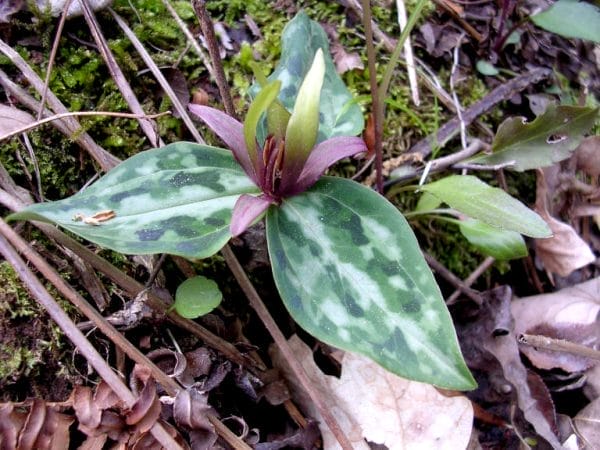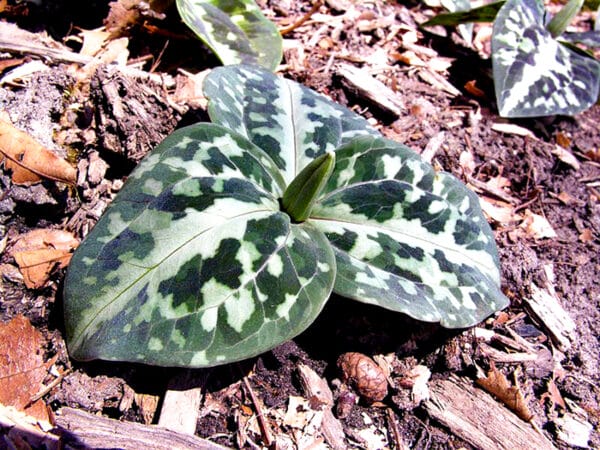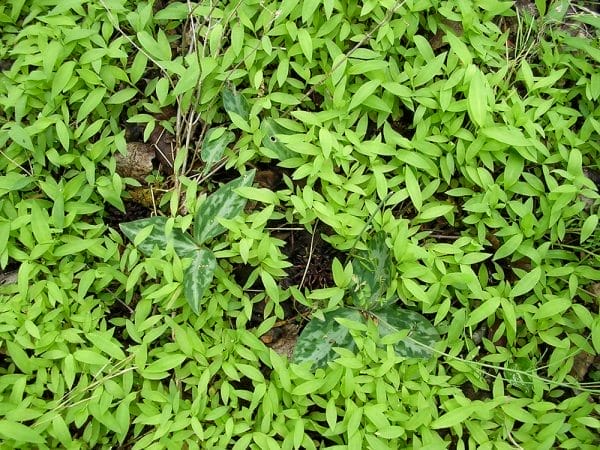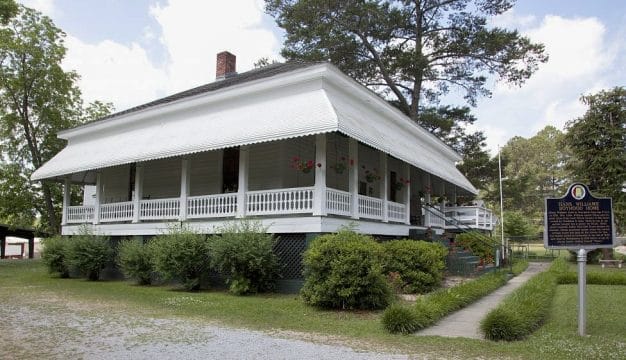Relict Trillium
 Relict Trillium
Relict trillium (Trillium reliquum) is a low-growing herbaceous perennial occasionally found in moist, rich, mixed deciduous hardwood forests along the fall line in Alabama, Georgia, and South Carolina. A member of the Liliales Order, which also includes such common plants as lilies and tulips, the relict trillium is one of 18 Trillium species in Alabama. The genus and common name, Trillium, was chosen for the family of plants by Swedish botanist Carl Linnaeus based upon the leaves and flower parts occurring in threes and its relationship to the lilies. Its species name was chosen because it is found in small isolated populations and may represent remnants of a species that was once more common and widespread and is a “relic” of a former ecosystem. It is also known locally as the Confederate wakerobin. Listed as federally endangered and considered rare in Alabama, it exists only in small populations in Bullock, Henry, and Lee Counties in the southeastern portion of the state.
Relict Trillium
Relict trillium (Trillium reliquum) is a low-growing herbaceous perennial occasionally found in moist, rich, mixed deciduous hardwood forests along the fall line in Alabama, Georgia, and South Carolina. A member of the Liliales Order, which also includes such common plants as lilies and tulips, the relict trillium is one of 18 Trillium species in Alabama. The genus and common name, Trillium, was chosen for the family of plants by Swedish botanist Carl Linnaeus based upon the leaves and flower parts occurring in threes and its relationship to the lilies. Its species name was chosen because it is found in small isolated populations and may represent remnants of a species that was once more common and widespread and is a “relic” of a former ecosystem. It is also known locally as the Confederate wakerobin. Listed as federally endangered and considered rare in Alabama, it exists only in small populations in Bullock, Henry, and Lee Counties in the southeastern portion of the state.
First collected in 1901 in Georgia, the relict trillium was not described and recognized as an individual species until 1975 by John D. Freeman, former professor and herbarium curator at Auburn University in Auburn, Lee County. Freeman gathered numerous Trillium species and examined more than 10,000 specimens during his extensive research and noted several specimens that appeared to be different from others. After additional study, Freeman concluded these specimens were a distinct and new species.
 Relict Trillium Flower Bud
The relict trillium is typically found in ravines, floodplains, bottomlands, and bluffs located near streams and large rivers. Relict trillium emerges from underground rhizomes in late winter and generally begins to flower in mid-March. It is a highly variable species that commonly exhibits differences in height, leaf size, leaf color, and flower color. Mature plants range in height from 2 to 9 inches (~5.5 to 24.5 centimeters) tall. Its three “leaves” are actually modified parts of the flower known as bracts. They vary in size and color, even in a single population, and can range from 2 to 5 inches (~5 to 13 centimeters) long by 2.5 to 4 inches (~6 to 10 centimeters) wide. Bract color ranges from light to dark green, bronze green, and occasionally dark purple, and the bracts frequently have a silver stripe down the mid-vein. A solitary flower with three petals is centered upon the S-shaped stem above the three bracts. This S-shaped stem, covered in soft downy hairs, is a distinguishing trait of relict trillium. Flower colors are typically purple to dark purple, but are on rare occasion yellow, and last two to three weeks. The attractive flowers smell of spoiled meat to attract the flies and beetles that are thought to be the main pollinators of this species. True bugs (Hemiptera Order) have also been observed to pollinate relict trillium.
Relict Trillium Flower Bud
The relict trillium is typically found in ravines, floodplains, bottomlands, and bluffs located near streams and large rivers. Relict trillium emerges from underground rhizomes in late winter and generally begins to flower in mid-March. It is a highly variable species that commonly exhibits differences in height, leaf size, leaf color, and flower color. Mature plants range in height from 2 to 9 inches (~5.5 to 24.5 centimeters) tall. Its three “leaves” are actually modified parts of the flower known as bracts. They vary in size and color, even in a single population, and can range from 2 to 5 inches (~5 to 13 centimeters) long by 2.5 to 4 inches (~6 to 10 centimeters) wide. Bract color ranges from light to dark green, bronze green, and occasionally dark purple, and the bracts frequently have a silver stripe down the mid-vein. A solitary flower with three petals is centered upon the S-shaped stem above the three bracts. This S-shaped stem, covered in soft downy hairs, is a distinguishing trait of relict trillium. Flower colors are typically purple to dark purple, but are on rare occasion yellow, and last two to three weeks. The attractive flowers smell of spoiled meat to attract the flies and beetles that are thought to be the main pollinators of this species. True bugs (Hemiptera Order) have also been observed to pollinate relict trillium.
Once pollination has occurred, fruits mature and seeds ripen until late June, when the fruits split open and disperse the seeds to the forest floor. Following the release of seeds, the aboveground parts slowly deteriorate and wither away and the rhizomes remain in a dormant state until the following winter. Sexual reproduction by seed is the primary form of producing new individuals. Asexual reproduction also can occur by the formation of vegetative offshoots arising from a single rhizome of large flowering individuals, but this method of reproduction is rare. As with many woodland understory species, the relict trillium requires many years to reach reproductive maturity. This species typically takes five to seven years to mature but can take up to ten years.
The relict trillium depends on insects in multiple ways. Not only does this species depend on insects to pollinate its flowers, it depends on ants to disperse its seeds. The seeds have an elaiosome, a fleshy structure attachment rich in fats and proteins that is attractive to ants. The ants collect the newly ripened seeds and take them to their nests. They then eat the elaiosome, leaving the seeds in the nest to sprout in the next growing season, protected from predators, fire, and competition.
 Trillium and Invasive Grass
In May 1988, the U.S. Fish and Wildlife Service (USFWS) gave the relict trillium official protection under the Endangered Species Act (ESA) of 1973 because it is in danger of extinction through almost all of its range. Current and future threats come from habitat destruction, habitat degradation, and other human caused factors. Deer herbivory, soil disturbance from feral pigs, and infringement by exotic, non-native plants such as kudzu and Japanese honeysuckle are also threats. The Alabama Natural Heritage Program lists relict trillium as “imperiled” in the state of Alabama based upon its rarity and vulnerability to disturbance, but this designation does not afford any protection under state law. In 1990, when the recovery plan for relict trillium was written by the USFWS, there were 21 known populations. These populations have more than doubled since then, but the majority of these populations occur on private or company-owned land, leaving them unprotected. In order to protect the relict trillium, voluntary legal agreements, or conservation easements, between private landowners and government agencies can reduce the threats from urban expansion, agriculture, and timber harvesting. The USFWS also recommends active management of encroaching non-native invasive plants and of increasing populations of white-tailed deer and feral swine.
Trillium and Invasive Grass
In May 1988, the U.S. Fish and Wildlife Service (USFWS) gave the relict trillium official protection under the Endangered Species Act (ESA) of 1973 because it is in danger of extinction through almost all of its range. Current and future threats come from habitat destruction, habitat degradation, and other human caused factors. Deer herbivory, soil disturbance from feral pigs, and infringement by exotic, non-native plants such as kudzu and Japanese honeysuckle are also threats. The Alabama Natural Heritage Program lists relict trillium as “imperiled” in the state of Alabama based upon its rarity and vulnerability to disturbance, but this designation does not afford any protection under state law. In 1990, when the recovery plan for relict trillium was written by the USFWS, there were 21 known populations. These populations have more than doubled since then, but the majority of these populations occur on private or company-owned land, leaving them unprotected. In order to protect the relict trillium, voluntary legal agreements, or conservation easements, between private landowners and government agencies can reduce the threats from urban expansion, agriculture, and timber harvesting. The USFWS also recommends active management of encroaching non-native invasive plants and of increasing populations of white-tailed deer and feral swine.
Additional Resources
Caspary, Melissa and James Rickard. “Assessing Conserved Populations of the Rare Relict Trillium (Trillium reliquum).” Natural Areas Journal 36 (January 2016): 59-67.
Currie, Robert R. “Recovery Plan for Relict Trillium (Trillium reliquum Freeman).” U.S. Fish and Wildlife Service Atlanta, Ga.: U.S. Fish and Wildlife Service, Southeast Region, 1991.
Gonzales, Eva, and James L. Hamrick. “Distribution of Genetic Diversity Among Disjunct Populations of the Rare Forest Understory Herb, Trillium reliquum.”Heredity 95 (August 2005): 306-14.



